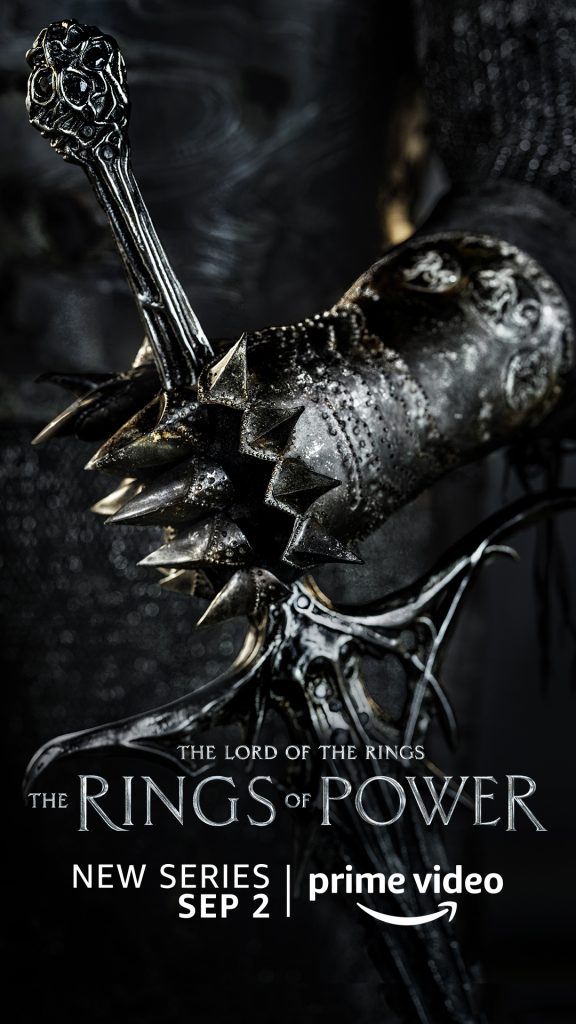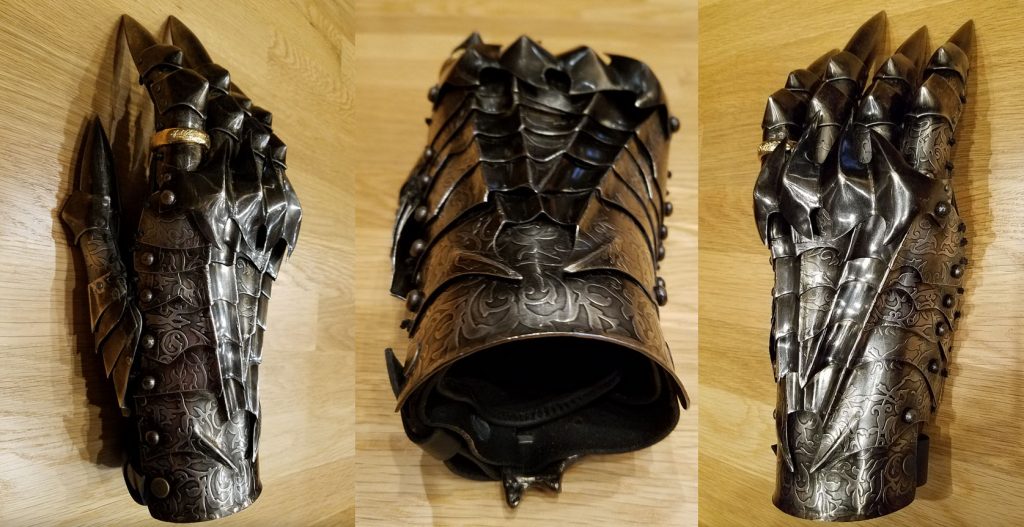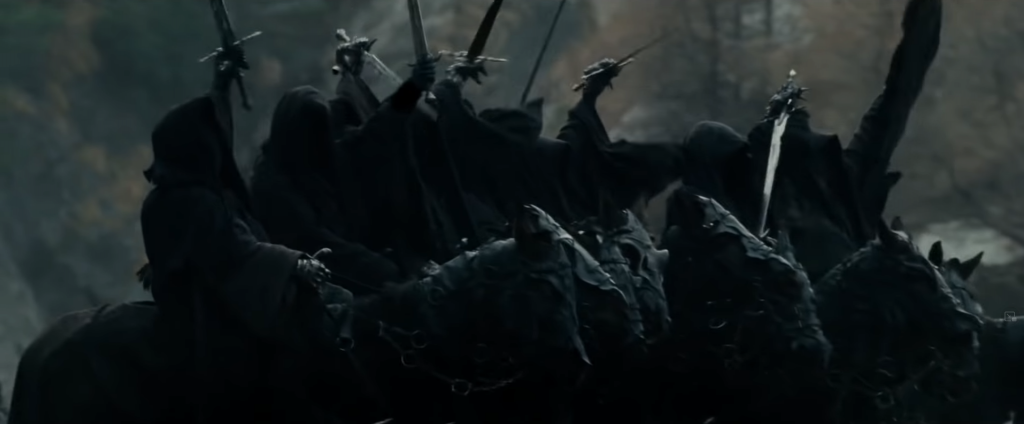My learned colleagues at TORnCentral have weighed in on the 23 images released yesterday by our good friends at Amazomg, but I’m keen to zero in on one and put it under the microscope.
It’s this one — let’s call it Gauntlet and Sword.

Gauntlet and Sword immediately recalls Jackson’s Third Age armoured Sauron. But there are obvious discrepancies when you compare it against the visual aesthetic that the Peter Jackson productions established.
First, at the Last Alliance confrontation between Gil-galad, Elendil and Sauron in the Fellowship of the Ring prologue, the latter bears a gigantic flanged mace, not a sword. (You can rewatch the entire prologue scene here if you like; Sauron appears about two minutes in.)
Gauntlet and Sword, on the other hand, shows, well, a sword. A blackened sword with a remarkably ornate hilt. But, still, a sword.
Second, the Amazon Studios gauntlet does not fully correspond to the one designed by WETA Workshop head Richard Taylor and his staff. The WETA gauntlet is a metal one, with articulated metal plates all the way past the wrist.

Sure, the gauntlet we see in Gauntlet and Sword is black and spiky, but from the promotional image provided, it lacks the articulated and overlapping metal plates that go all the way to the wrist. Instead, the articulation appears to stop at the knuckles. The general effect looks more like a studded, heavy leather gauntlet than one carefully assembled from many metal plates.
Finally, it’s important to note that before the Akallabêth — the period that Rings of Power seems likely to focus on at first, Sauron was not bound to that terrible and intimidating form. Instead:
…in his earlier incarnation he was able to veil his power (as Gandalf did) and could appear as a commanding figure of great strength of body and supremely royal demeanour and countenance.
The Letters of J.R.R. Tolkien. Letter #246.
One must conclude that either:
1) This is not actually Sauron
2) It is Sauron, but Amazon Studios is moving away from “the PJ look”
When we have cosplayers doing intensive research and nailing all the details with incredible detailed replica Sauron costumes, it defies logic that Amazon Studios couldn’t do the same with their sky-high budget. If they so desired.
The impression that I have long had is that Amazon Studios has been trying to hew to the aesthetic Jackson created. In itself, choosing New Zealand as the original shooting location fits this thesis — although I am sure financial considerations come into play there, too.
It makes sense — the PJ aesthetic has a lot of penetration through the popular consciousness and pop culture. Leveraging it is a low-effort way to get buy-in from viewers.
And the original Amazon Studios tease image carries a great deal of PJ aesthetic in the architecture of Tirion upon Túna.
So I don’t think Amazon Studios is drifting from the PJ look . Instead, what we have is some artful misdirection — we are being teased with the superficial appearance of Sauron using typical signifiers that we subconsciously associate with the lord of Barad-dûr, but there are enough clues for us to dismiss it.
This is not Sauron.
For similar reasons I would discard the Witch-king of Angmar — the gauntlet doesn’t match (you can get a good look at Wiki’s gauntlet at 1 min and 6 secs in this clip where he confronts Éowyn) , and although Wiki carries a sword (as well as a massive flail), its design is a lot cleaner than the one in Gauntlet and Sword. In fact the swords of all the Nazgul are very minimalist with flat or slightly curved crossguards.

So, who is it?
I’m going to outline a handful of outlandish possibilities. All speculation, of course.
Option 1. Túrin.
Black sword, right? Also, The Silmarillion outlines how the folk of Nargothrond equip Túrin with “dwarf-mail, to guard him”. Further, The Silmarillion describes from the perspective of Tuor and Voronwë the following scene at the Well of Ivrin after the sack of Nargothrond.
But even as they gazed upon it they saw one going northward in haste, and he was a tall Man, clad in black, and bearing a black sword. But they knew not who he was, nor anything of what had befallen in the south; and he passed them by, and they said no word.
Of Tuor and the Fall of Gondolin
Nevertheless, the other image with a broken black sword somehow seems a better fit for Túrin.
Option 2. Eöl or Maeglin.
Gurthang (or Anglachel, if you prefer) is not the only black sword to feature in The Silmarillion. There is another: Anguirel. Eöl, the Dark Elf, forges both as a pair. The former he gave to Thingol, the latter he kept for himself. Anguirel then ends up in the hands of his son, Maeglin, when Aredhel and Maeglin flee Eöl’s controlling nature.
Canonically, both Eöl and Maeglin meet nasty ends in Gondolin; the ultimate fate of Anguirel is unknown. Because Maeglin is tossed over the walls of Gondolin during its sack, it’s only a bit of a stretch that he might have survived (but it is a stretch). And the emblem of Maeglin’s house was a plain black field with no symbol whatsoever.
Could Tolkien Estate be convinced to allow Maeglin to be used as a returning Second Age antagonist? I don’t know. It’s a thought.
Props to posters over on the LOTR on Prime sub-reddit for raising this one. Intriguing.
Option 3. Morgoth.
Must confess, I started considering this because of John Howe’s famous image of Ungoliant and Melkor about to do the dirty on the Two Trees. Melkor, all in black, has in hand an enormous black greatsword. Not canonical — in The Silmarillion he uses a spear: “Melkor sprang upon the mound; and with his black spear he smote each Tree to its core, wounded them deep”. However, John Howe has been providing art for the Amazon Studios production.
In The Silmarillion, Beleg also uses the appellation “Black Hand” at one point to describe Morgoth. If we get the Two Trees, we must surely get Morgoth at some point. Right?
The current rumour: Adar
The current suggestion via Fellowship of the Fans is that it corresponds to a character known as “Adar” (originally codenamed “Oren”). Adar is a Sindarin word that translates as “father” and the role is supposedly being filled by Joseph Malwe.
To reprise, Adar is said to be an “corrupted” and “tortured” elf who oversees a group of orcs who see him as a father figure. Hence the name, Adar. Further, the rumour states that this elf is one of the brothers of Galadriel — but not Finrod Felagund. This offers two choices: Angrod and Aegnor, both of whom canonically perished in The Battle of Sudden Flame (Orodreth should properly be considered to be Angrod’s son).
These are choices that seem much more out of canon than, say, the Maeglin option. The Silmarillion’s text declares “the sons of Finarfin bore most heavily the brunt of the assault, and Angrod and Aegnor were slain”.
Could they work? I guess.
There’s this to consider:
But ever the Noldor feared most the treachery of those of their own kin, who had been thralls in Angband; for Morgoth used some of these for his evil purposes, and feigning to give them liberty sent them abroad, but their wills were chained to his, and they strayed only to come back to him again. Therefore if any of his captives escaped in truth, and returned to their own people, they had little welcome, and wandered alone outlawed and desperate.
Of the Ruin of Beleriand and the Fall of Fingolfin
Additionally, in the Lord of the Rings, Gandalf says to Frodo:
The Elves may fear the Dark Lord, and they may fly before him, but never again will they listen to him or serve him [emphasis mine].
Many Meetings
And service need not be direct, or knowing as in the case of Húrin.
When therefore he judged the time to be ripe, [Morgoth] released Húrin from his bondage, bidding him go whither he would; and he feigned that in this he was moved by pity as for an enemy utterly defeated. But he lied, for his purpose was that Húrin should still further his hatred for Elves and Men, ere he died.
Of the Ruin of Doriath
Placed against that, consider Gwindor son of Guilin. An escaped thrall, he not only assists Beleg and succors Turin at risk to himself, he is also seemingly welcomed back to Nargothrond without suspicion or fear.
Still, there might be a way for Amazon Studios to work a story of pathos and miscalculation, if they can find some subtlety. We’ll see.


